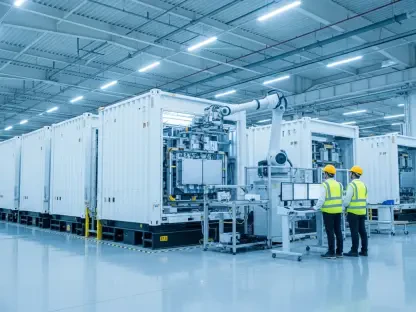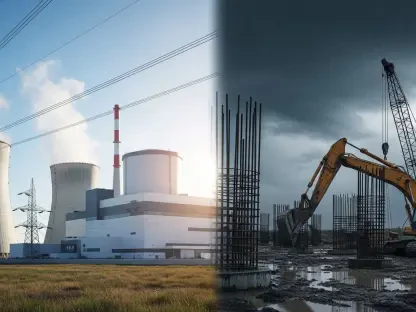The Gulf Coast, especially in states like Texas, Louisiana, and Mississippi, is facing increasing challenges in storing renewable energy generated from solar and wind sources. Due to the unique geographical features of these states and the inherent limitations with traditional energy storage methods, there has been a pressing need for innovative solutions. One such promising approach is Cavern Energy Storage, which leverages the region’s natural salt domes for long-duration energy storage. This method aims to address the region’s specific needs while providing a reliable and efficient energy storage solution.
The Urgency for Long-Duration Energy Storage
With the accelerating adoption of renewable energy, Gulf Coast states are experiencing a critical need for dependable and efficient energy storage systems that can handle the intermittent nature of solar and wind energy production. For instance, Texas has witnessed an increase in grid volatility due to the fluctuating output from renewable sources, making it essential to have effective energy storage solutions to balance supply and demand. Inconsistent energy generation from these renewable sources creates challenges in ensuring a stable and reliable energy supply.
The United States Department of Energy (DOE) has recognized this urgency and responded with initiatives like the Energy Storage Grand Challenge. Despite these efforts, traditional energy storage systems have proven unsuitable for meeting the specific requirements of the Gulf Coast region. This significant gap in energy infrastructure has propelled the development of innovative solutions like Cavern Energy Storage, designed to address the region’s unique challenges. By leveraging natural salt dome formations, the Cavern Energy Storage project aims to provide a viable and efficient solution tailored to the needs of Texas, Louisiana, and Mississippi.
Challenges with Conventional Energy Storage Approaches
Conventional energy storage methods, such as pumped storage hydropower, require substantial elevation differences between water reservoirs, making them impractical for the flat terrains characteristic of the Gulf Coast. This geographical constraint has rendered traditional pumped storage solutions unfeasible in regions like Texas, Louisiana, and Mississippi. The flat landscapes of these states pose a significant hurdle to the deployment of such systems, necessitating the exploration of alternative solutions better suited to their topography.
Additionally, lithium-ion batteries, although widespread for short-term energy storage, come with their own set of limitations. These batteries face issues such as a short lifespan, dependence on scarce and expensive resources, and limited efficiency in handling large-scale, long-duration energy storage. Given these shortcomings, lithium-ion batteries are not considered viable for the Gulf Coast’s long-term energy storage needs. The search for sustainable and efficient energy storage solutions that can adapt to the unique landscape of the Gulf Coast is thus ongoing and critical.
Leveraging Salt Domes for Energy Storage
The Gulf Coast region is rich in salt domes, vast underground formations composed primarily of salt. Historically utilized to store various fluids, including oil and natural gas, these geological structures offer a novel opportunity for energy storage. Cavern Energy Storage proposes repurposing these salt domes to build underground pumped storage hydroelectric systems, effectively adapting the principles of traditional pumped storage to flat terrains. This innovative approach takes advantage of the unique geological features of the Gulf Coast to solve its energy storage challenges.
The methodology involves drilling wellbores into salt domes at various depths to create underground caverns through a process known as solution mining. During this process, water is pumped into the wells, dissolving the salt, and forming expansive storage caverns within the domes. As the brine is extracted, it can be processed to retrieve salt crystals, which generate an additional revenue stream that helps offset the construction costs. By leveraging the natural properties of salt domes, Cavern Energy Storage aims to provide a scalable and efficient energy storage solution tailored to the specific needs of the Gulf Coast region.
Methodology and Process
Creating underground pumped storage hydroelectric systems within salt domes involves several precise and methodically planned steps. The process begins with the drilling of large wellbores into the salt domes, extending to varying depths to create expansive storage cavities. Solution mining is then employed, where water is injected into the salt formations to dissolve the salt and form underground caverns. This technique generates substantial storage spaces within the domes, uniquely suited for energy storage applications in the flat terrains of the Gulf Coast region.
The brine extracted during the solution mining process is subsequently treated to recover salt, which can be sold to create an additional revenue stream. Once the caverns are formed, compressed air is used to facilitate the movement of brine, enabling efficient energy storage and retrieval through a surface pump/turbine system. This innovative approach allows for the effective utilization of the stored energy, providing a reliable and long-term energy storage solution. By repurposing the existing geological formations of the Gulf Coast, Cavern Energy Storage offers a practical and scalable method to meet the region’s energy storage needs.
Economic and Environmental Advantages
Cavern Energy Storage offers significant economic and environmental benefits by leveraging a modular “LEGO” design for its energy storage systems. This modularity allows for scalable and repetitive construction, reducing overall project costs and ensuring schedule reliability. Moreover, the use of saturated salt brine instead of fresh water in the storage process conserves vital water resources, making the system not only economically viable but also environmentally sustainable. The estimated round-trip efficiency of around 80% underscores the long-term reliability of these systems.
In addition to providing consistent energy supply, Cavern Energy Storage systems reduce the reliance on less efficient peak power plants, consequently lowering overall carbon dioxide emissions. This reduction in emissions contributes to environmental sustainability, aligning with broader efforts to mitigate climate change. The combination of economic viability, environmental sustainability, and technological innovation makes Cavern Energy Storage an attractive and promising solution for addressing the Gulf Coast’s energy storage challenges. By offering a sustainable and cost-effective approach, this technology helps pave the way for a more stable and reliable renewable energy future in the region.
Market and Policy Considerations
The Gulf Coast, particularly in states like Texas, Louisiana, and Mississippi, is grappling with growing challenges in storing renewable energy from solar and wind sources. The unique geography of these states, combined with the limitations of traditional energy storage methods, underscores the need for innovative solutions. A promising approach gaining traction is Cavern Energy Storage, which utilizes the natural salt domes found in these regions for long-duration energy storage. This method is being seen as a way to meet the specific energy storage needs of the Gulf Coast while offering a reliable and efficient solution.
The current energy storage systems often fail to provide the long-term storage required for renewable sources. Traditional batteries, while useful, are generally not designed for the prolonged storage needed to balance supply and demand effectively. This is where the Gulf Coast’s natural salt caverns come into play. These geological formations, already known for their use in storing natural gas and petroleum, offer a viable solution for renewable energy storage. By repurposing these salt domes, we can provide a steadfast and efficient way to store large amounts of energy, thus aiding in the transition to more sustainable energy solutions in the region.









